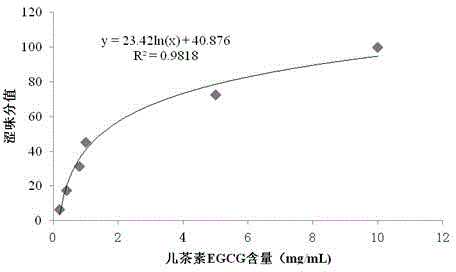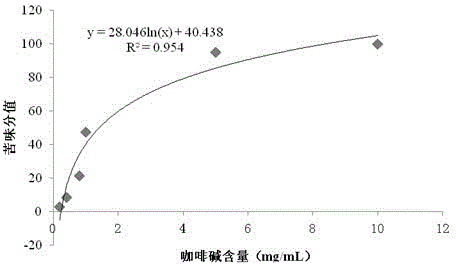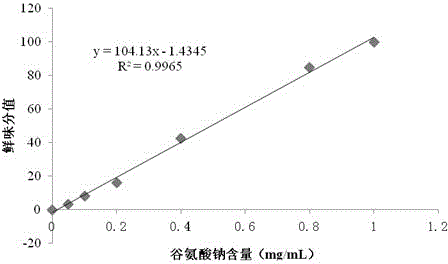Method for analyzing taste intensity of tea soup
A technology for the taste intensity and taste intensity value of tea soup, which is applied in the field of tea flavor analysis, and can solve problems such as unsatisfactory tea evaluation methods
- Summary
- Abstract
- Description
- Claims
- Application Information
AI Technical Summary
Problems solved by technology
Method used
Image
Examples
Embodiment 1
[0020] Embodiment 1: A kind of method for analyzing the taste intensity of tea soup
[0021] (1) Use catechin EGCG, caffeine, sodium glutamate and sucrose as standard products for astringency, bitterness, umami and sweetness, and prepare different concentrations (of which catechin EGCG: 0, 0.2, 0.4, 1.0 , 5.0, 10.0 mg / mL; caffeine: 0, 0.2, 0.4, 1.0, 5.0, 10.0 mg / mL; sodium glutamate: 0, 0.05, 0.1, 0.2, 0.4, 0.8, 1.00 mg / mL; sucrose: 0 , 0.5, 1.0, 2.0, 4.0, 8.0, 10.0 mg / mL) solution as taste intensity standard solution;
[0022] (2) Determine the taste intensity values of the standard solutions of different concentrations obtained in step 1) according to the intensity of astringency, intensity of bitterness, intensity of umami and intensity of sweetness;
[0023] (3) Correlation analysis was performed between the taste intensity values of different standard solutions obtained in step 2) and the contents of chemical components in the standard solutions, and the standard cur...
Embodiment 2
[0028] Embodiment 2: A kind of method for analyzing the taste intensity of tea soup
[0029] (1) Use catechin EGCG, caffeine, sodium glutamate and sucrose as standard products for astringency, bitterness, umami and sweetness, and prepare different concentrations (catechin EGCG: 0, 0.2, 0.4, 1.0, 5.0, 10.0 mg / mL; caffeine: 0, 0.2, 0.4, 1.0, 5.0, 10.0 mg / mL; sodium glutamate: 0, 0.05, 0.1, 0.2, 0.4, 0.8, 1.00 mg / mL; sucrose: 0, 0.5, 1.0, 2.0, 4.0, 8.0, 10.0 mg / mL) as the taste intensity standard solution;
[0030] (2) Determine the taste intensity values of the standard solutions of different concentrations obtained in step 1) according to the intensity of astringency, intensity of bitterness, intensity of umami and intensity of sweetness;
[0031] (3) Correlation analysis was performed between the taste intensity values of different standard solutions obtained in step 2) and the contents of chemical components in the standard solutions, and the standard curves of taste int...
Embodiment 3
[0036] Embodiment 3: A kind of method for analyzing the taste intensity of tea soup
[0037](1) Use catechin EGCG, caffeine, sodium glutamate and sucrose as standard products for astringency, bitterness, umami and sweetness, and prepare different concentrations (catechin EGCG: 0, 0.2, 0.4, 1.0, 5.0, 10.0 mg / mL; caffeine: 0, 0.2, 0.4, 1.0, 5.0, 10.0 mg / mL; sodium glutamate: 0, 0.05, 0.1, 0.2, 0.4, 0.8, 1.00 mg / mL; sucrose: 0, 0.5, 1.0, 2.0, 4.0, 8.0, 10.0 mg / mL) as the taste intensity standard solution;
[0038] (2) Determine the taste intensity values of the standard solutions of different concentrations obtained in step 1) according to the intensity of astringency, intensity of bitterness, intensity of umami and intensity of sweetness;
[0039] (3) Correlation analysis was performed between the taste intensity values of different standard solutions obtained in step 2) and the contents of chemical components in the standard solutions, and the standard curves of taste inte...
PUM
 Login to View More
Login to View More Abstract
Description
Claims
Application Information
 Login to View More
Login to View More - R&D
- Intellectual Property
- Life Sciences
- Materials
- Tech Scout
- Unparalleled Data Quality
- Higher Quality Content
- 60% Fewer Hallucinations
Browse by: Latest US Patents, China's latest patents, Technical Efficacy Thesaurus, Application Domain, Technology Topic, Popular Technical Reports.
© 2025 PatSnap. All rights reserved.Legal|Privacy policy|Modern Slavery Act Transparency Statement|Sitemap|About US| Contact US: help@patsnap.com



